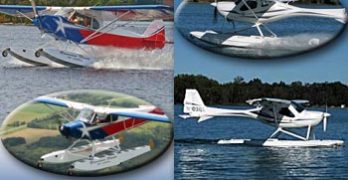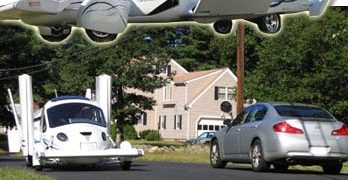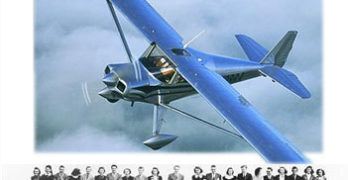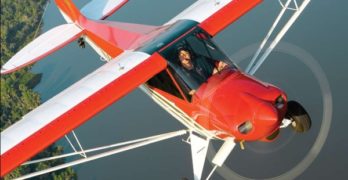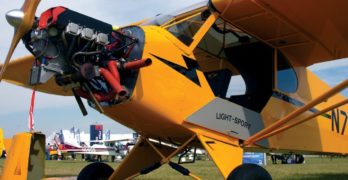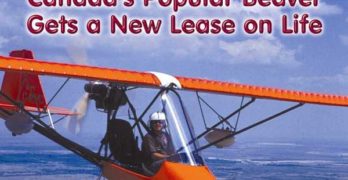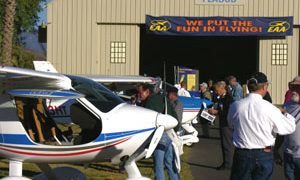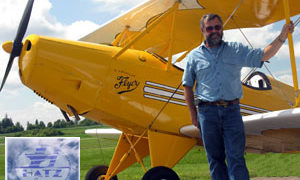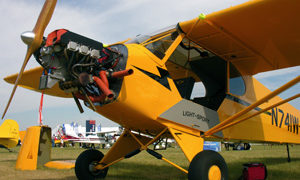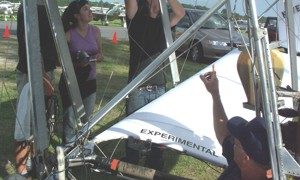We’ve arrived at the end of the main float-flying season, but two of our largest Light-Sport Aircraft manufacturers just announced floatplane models. Welcome to the American Legend FloatCub and the Remos GX on floats. Each company contracted with float experts (a big difference from SeaMax or SeaRey). *** The most successful American LSA producer, American Legend won approval on October 2 for their Amphibious Legend FloatCub after declaring they met ASTM standards. FloatCub was put on sale for $159,000 and the first customer aircraft is being assembled. Legend went to long-established float company, Baumann Floats of New Richmond, Wisconsin. The new model flew in July, 2009 and made an appearance at Oshkosh. Unlike original Piper Cubs that were often put on floats, the Legend Cub has doors on both sides, a big benefit when docking. If purchased with the 120-hp Jabiru 3300, Legend FloatCub should prove quite energetic even at high elevations.
Search Results for : vintage
Not finding exactly what you expected? Try our advanced search option.
Select a manufacturer to go straight to all our content about that manufacturer.
Select an aircraft model to go straight to all our content about that model.
“New Wave” LSA, Part 1 — Terrafugia Transition
Recently, I visited three brand-new LSA developments. All are American. All are propelled by young engineers and enthusiasts. All are remarkably sophisticated. All companies have been successful at raising funds. And, perhaps most notably, all projects were started specifically because of the emergence of the Light-Sport Aircraft rule. *** All three are emphatically not reconfigured European microlights or vintage American designs…not that I have any objection to such aircraft. I am simply encouraged by fresh new designs from fresh young faces. Aviation needs that! *** My first example (others soon) is the Terrafugia Transition. Called a “roadable aircraft” rather than a “flying car,” Terrafuguia does what others have done but in a new, far more practical way. Compared to the Transition, Molt Taylor’s Aerocar is so last century. Transition folds its wings without leaving the cockpit. The company has produced a professional video that explains the concept and the award winning people behind it.
Silvery LSA-8 Has a Great Tradition, Now Built New
Clyde Cessna. William Piper. Walter Beech. Al Mooney. William Boeing. You knew all that.
But do you recall the name Donald Luscombe? You probably should.
The Luscombe Aircraft Company built some 8,000 aircraft, 6,000 of them the Silvaire model alone. And they once pumped out as many as 23 per day, yes, per day! In 1948, Luscombe produced more than 2,700 aircraft in a calendar year. That’s more than twice as many as all LSA companies combined have sold in three years.
Fortunately, it isn’t just a history lesson. Thanks to John Dearden and staff at Flabob Airport in Southern California, the Luscombe was revived as the LSA-8 earning approval as a Special Light-Sport Aircraft.
Lucky me, I went flying in it with John and a pleasure it was. Great manners in a responsive, good performing, all-metal, Continental-powered LSA that is 100% Made in the USA. Selling for around $90,000 LSA-8 looks inexpensive compared to euro-denominated LSA now running to $130,000.
CubCrafters All-New Sport Cub
Vintage Looks Mated With Modern Materials
Take 25 years of experience
with rebuilding Piper Cubs,
add a new FAA regulation
allowing more flexibility in designing
and producing aircraft, spice the
mixture with many design changes,
and you get CubCrafters’ Sport Cub.
The Yakima, Washington-based company
has created an airplane that retains
the vintage look of a J-3 Cub
but embraces 21st century materials
and technology.
On a warm evening during
the Sun ‘n Fun Fly-In
at Lakeland, Florida, I
flew with CubCrafters’
pilot Clay Hammond. He
identified company President
Jim Richmond as the primary
motivator behind the Sport Cub.
Richmond has been rebuilding Cubs
for 25 years, during which time he
conceived many changes he wanted
to try. Taking into consideration his
height-he’s 6 feet 4 inches tall-he
wanted to make all the improvements
he’d envisioned for the venerable
Cub, and he wanted the airplane
to fit him.
A Thoroughly Modern Cub
CubCrafters took on the redesign
of the 50-year-old airplane using
modern materials and engineering
software not available to Piper engineers
when the J-3 was created.
Certifying LSA
A Review of the Industry Consensus Standards Method
In the aviation world, the new light sport aircraft category is all the rage, with interest at aviation trade shows climbing off the charts. New aircraft certified using ASTM International industry consensus standards recently reached model number 50, with all approvals coming in less than two years, a record in aviation history worldwide.
Doing things correctly and quickly is not uncommon in the world of light sport aircraft. This is a highly entrepreneurial activity populated by get-it-done businessmen and women who are highly motivated to get their nascent industry off the ground – literally.
Welcome to Committee F37
ASTM International’s Committee F37 on Light Sport Aircraft is just five years old, yet it has produced, from scratch, specifications for design, performance, quality acceptance tests and safety monitoring for LSA. ASTM standards guide the preparation of pilot operating handbooks, maintenance manuals, and a system of service bulletins to advise consumers of maintenance needed to keep their aircraft in good operating condition.
Beaver RX-550
Perhaps the most famous ultralight to come out of Canada is the Beaver. With a reported 2,200 units flying since the early 1980s, this is one of the most successful light aircraft ever. However, due to missteps by companies that previously manufactured the brand, this popular ultralight was nearly lost from the ultralight aviation landscape. Were it not for the Aircraft Sales and Parts (ASAP) company and the Holomis family, you might not have this choice today.
Originally the Beaver RX-550 came from a company called Spectrum Aircraft. A company reorganization left the ultralight in the hands of a company named Beaver RX Enterprises. Both these business names disappeared and today the ASAP brand carries the Beaver into the sky.
In 1993, a couple years after our last report on the Beaver1, the old company closed its doors and effectively stranded thousands of Beaver ultralight owners and all the dealerships that sold them.
Sport Pilot Tour Revs High at Historic Flabob
A fleet of shiny Special Light-Sport Aircraft assembled at historic Flabob Airport despite persistent high winds in the southwest. Under an usually clear blue sky, a record 17 models gathered at the vintage airport in Riverside, California. EAA promotional efforts attracted about 600 LSA-oriented attendees. Hosted by EAA Chapter 1 in their excellent facility provided through generosity of Poly Fiber developer Ray Stitts, a steady audience of 200 filled seats throughout the day to have their Sport Pilot questions answered by EAA expert Ron Wagner. One of the newest certified SLSA, the Luscombe Silveraire, is built at Flabob. Owner John Dearden showed me many dozens of pallets holding tooling dies once used to mass manufacture as many as 29 Luscombe aircraft per day! In the vast basin of LA cites, Flabob is an aviation oasis saved from home developers by the Tom Wathen Foundation which operates an aviation high school on airport grounds.
Gorgeous, Award-Winning Biplane from Duluth
EAA’s Minneapolis Sport Pilot Tour, plagued at first with some logistical challenges, came off very well. More than 500 LSA-interested attendees showed up at Airlake airport south of the Twin Cities metro. The local Sport Pilot school, LSA North at the Aircraft Resource Center, exhibited their CTs along with the Sportstar, KP-5, RANS S-6 and S-7 and others. One of the charmers was the award-winnng Hatz Bantam from builder Mark Marino. The Bantam is an evolution of the original John Hatz biplane designed in the 1960s. Leap forward in time and the lighter Hatz can be flown by a Sport Pilot. Previously only plans were available but Marino is now working on Hatz Partz, components that represents elements of a full kit. The 1,320 pound Bantam is powered by a 120-hp Jabiru 3300 six cylinder four stroke. It can carry a couple two hundred pounders and fly 110 mph.
Legend is First Cub to Sport a Jabiru Engine
Legend Aircraft‘s Cub is one of the top selling SLSA, ranking up high with Flight Design’s CT, Fantasy Air’s Allegro, Evektor’s SportStar, and TL Ultralight’s StingSport. Both American-made Cub-like designs (Legend’s and CubCrafters‘) have been 100% Continental O-200 powered because that engine is close to what was used in the original Piper J-3 Cub, which has driven demand from customers attracted to the vintage aircraft. However, the Cubs have higher empty weights than many of their smaller metal or composite competitors — CT and StingSport, being primarily carbon fiber airframes, weigh in almost 200 pounds lighter, for example. So, when operating at higher elevations or on floats, reported Legend staffer Pat Bowers, some owners felt more power would be useful. For several weeks the Sulphur Springs, Texas factory worked to install the Jabiru 3300. The six cylinder engine is 35 pounds lighter and has 20 more horsepower, a combination said to provided spirited performance.
Pioneer in Ultralight Industry Still Going Strong
John K. Moody is widely acclaimed as the “Father of Ultralights,” and he makes effective use of that unique title to publicize his new millennium act featuring his last millennium ultralight.
Is Moody really the father of ultralights or the first to fly one? Several other enthusiasts were experimenting with power units for various kinds of hang gliders in the mid-1970s when Moody started. His distinction was that he was the first person to foot-launch and climb from flat terrain without benefit of wind or a slope.
I saw Moody fly in the summer of 1975 when he performed before about 250 hang glider pilots in a contest on the sand dunes near Frankfort, perched on the eastern shore of Lake Michigan. He began this risky behavior on March 15, 1975, above a frozen lake southwest of Milwaukee, at age 32.
Into almost still winds at the end of a day of hang-gliding competition, Moody ran his heart out and coaxed his Icarus II biwing hang glider off the beach with a 10-hp West Bend engine giving him some push.
- « Previous Page
- 1
- …
- 8
- 9
- 10
- 11
- 12
- Next Page »


